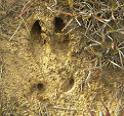L-5523
02-11
 Feral hog populations are expanding in Texas, impairing water quality, damaging native plant and animal communities, wrecking landscapes and gardens, and reducing agricultural production in many areas of the state. To develop management strategies for feral hogs, a landowner or manager needs to understand their behaviors and recognize their signs.
Feral hog populations are expanding in Texas, impairing water quality, damaging native plant and animal communities, wrecking landscapes and gardens, and reducing agricultural production in many areas of the state. To develop management strategies for feral hogs, a landowner or manager needs to understand their behaviors and recognize their signs.
Feral hogs leave evidence, or sign, of their passing. The most noticeable sign is the damage caused by their destructive rooting behavior. However, during a drought, rooting is minimal, and other signs are more common, such as hog wallows, rubs, tracks, trails, droppings, and beds.
Hogs are very mobile and routinely travel from one field that offers cover to another field that provides food. To increase trapping success, look for signs to determine their key travel corridors, which include creeks, sloughs, ponds, and other water sources.
Rooting damage
As feral hogs feed, they may severely damage native plant and animal communities as well as agricultural crops. If the hogs’ rooting in an area disturbs vegetation and soil extensively, the type and
abundance of plants there can shift. Rooting damages lawns, gardens, hay pastures, and native range (Fig. 1). It can also reduce the number of plant species in an area.
Feral hog diets differ throughout the year, depending on the availability of a wide variety of food items. During drought, they compete with native wildlife species for acorns, pecans, and other food.
Crop damage
Field crops commonly damaged by feral hogs include rice, sorghum, wheat, corn, soybeans, peanuts, potatoes, watermelon, and cantaloupe. Hogs not only consume planted seed, emerging seedlings, and maturing fruits and grains, but they also trample crops (Fig. 2).
Wallows and rubs
During warm months, feral hogs create wallows in moist areas near ponds, creeks, and sloughs (Fig. 3) to access mud, which helps them cool down and ward off biting

Figure 3A. Wallows (A) can be found in wet areas during warmer
months, and rubs are often associated with them.
insects. In hot weather, hogs often lie in wallows during the day. They deposit waste in these locations that is likely to contribute bacteria and pathogens to stream systems.
After wallowing, hogs rub on fixed objects to remove dried mud, hair, and parasites. Look for mud and hair on trees, fallen logs, fence posts, rocks, and utility poles,
particularly those near water or wallows. Hogs have an affinity for utility poles treated with creosote, and many poles within a hog’s home range will have visible markings.
Feral hog tracks and trails
Feral hog tracks and trails may yield information on abundance, animal size, direction of travel, and local behavior patterns. Hoofed tracks generally register two toes but may also show two dewclaws, which are smaller toes found higher on the leg.
Hogs have blunted or rounded toes, and this trait is apparent in tracks they leave behind. Deer tracks are typically heart- or spade-shaped; feral hog tracks appear more rounded (Fig. 4).
A well-worn feral hog trail indicates frequent use, and a lack of vegetation along the trail may suggest that many hogs use the path (Fig. 5). Where trails cross under fences, the hogs often leave hair and mud on the wires as they pass underneath.
Feral hog droppings
Examining hog droppings can reveal what hogs have been eating, which may help determine appropriate control methods or trap locations. Feral hogs are omnivorous, eating both plant and animal matter, and their diet varies by location and season. For these reasons, feral hog droppings take many forms, which can make identification difficult.
Hog droppings are often tubular, filled with mast (such as acorns and pecans) and other vegetation. The shape and consistency of their droppings ranges from that resembling
those of domestic dogs to those of horses (Fig. 6). A diet of young grasses and shoots results in loose tubes and formless patties.
Feral hog beds
Hogs create shallow beds by overturning the soil to expose the cool dirt in which they lay. During the heat of the day, feral hogs spend a significant amount of time in beds. They typically bed in dense vegetation such as vines, brambles, fallen trees, and other thick or thorny plants (Fig. 7). These areas offer security and shade and may be difficult to identify.
To find bedding locations, follow the hog trail into extremely thick vegetation. Hog beds are also often associated with wallowing areas.
Summary
Recognizing the signs of feral hog activity is critical to developing a management strategy. Signs include rotting damage, crop damage, wallows, rubs, tracks, trails, droppings, and beds. These signs can yield much information about feral hog activity.













